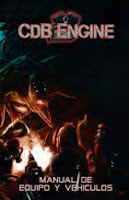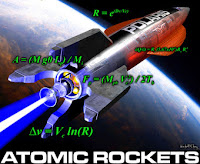In today's post I will suggest you historical, scientific and technological dissemination works I think you may find interesting whether you are into creation of worlds (also known as worldbuilding) or you want to satisfy your curiosity and desire for knowledge.
In future blog posts I will surely make reference to these works, in fact this post can be considered as an appendix to the series I devoted to Personas y dados, the guide to design roleplaying games that published by HT Publishers in 2021:
- Personas y dados: A guide to design role-playing games
- Personas y dados: Literary and game design resources(*)
- Personas y dados: Dice, licenses and game systems
- Personas y dados: Software for role-playing designers
(*) As I said in this post it's advisable to read all you can find.
Civilizations, societies, culture, technology and roleplaying and board games

|

|
|
|
Francis Tresham (2011) Photo by McGran (Public Domain) |
Civilization box art scan by Stan Shebs (Fair Use) |
Before starting to talk about these science communication works starring this post I think it's opportune to show you how the technological development has been addressed in roleplaying and board games, which takes me to introduce the following concepts:
- Technology Tree
- Concept created by the British game designer Francis Tresham (1936-2019) for the 1980's boardgame Civilization, which describes the civilization's evolution in the Mediterranean between 8000 BC and 250 BC.
Games using the technology tree allow players' civilizations advancing through investigation and experimentation, which at the same time brings the obtention of new knowledge and technologies based in these discoveries (namely, certain advances won't be possible if certain previous requirements aren't fulfilled).
Technology trees had been used since then in later Civilization editions as well as in strategy video games. - Technology Levels
- In games like Traveller or GURPS technology levels allow to define the development levels of civilizations and game worlds, thus indicating the resources and equipment the characters will have access to and the difficulty to use and/or understand all they will find in technological levels far from their own.
Having seen this little explanation about technological trees and levels it's worthy to take a look to practical examples of these elements in roleplaying games:

|

|
|
|
Cover of the Spanish edition of Mongoose Traveller 2ed Ediciones Sugaar (Fair Use) |
Cover of the original edition of GURPS Traveller Steve Jackson Games (Fair Use) |
First of all I show you the comparative table between the technology levels of Traveller and those of GURPS (which also published an adaptation of Traveller) taking as a basis the data in Technology Level/meta - Traveller and in the basic manual of Mongoose Publishing Traveller 2ed (published in Spain by Ediciones Sugaar).
| Comparative table of Technology Levels (TL): Traveller | GURPS 3e 4e | ||||
|---|---|---|---|---|
| Traveller | Historical Era | GURPS 3e | GURPS 4e | |
| 0 | Primitive | Stone Age | 0 | 0 |
| 1 | Primitive | Bronce Age (3500 BC) | 1 | 1 |
| 1.3 | Primitive | Iron Age (1300 BC) | 2 | 2 |
| 1.6 | Primitive | Medieval Era (600 AD) | 3 | 3 |
| 2 | Primitive | Age of Sail (1500 AD) | 4 | 4 |
| 3 | Primitive | Industrial Revolution (1730 AD) | 5 | 5 |
| 3.3 | Primitive | Near 1800 AD | 5 | 5 |
| 3.6 | Primitive | Near 1850 AD | 5 | 5-6 |
| 4 | Industrial | Mechanized Age (1900 AD) | 5 | 6 |
| 5 | Industrial | Broadcast Age (1930 AD) | 6 | 6 |
| 6 | Industrial | Nuclear Age (1940 AD) | 6 | 7 |
| 7 | Prestellar | Space Age (1970 AD) | 7 | 7 |
| 8 | Prestellar | Digital Age (1990 AD) | 8 | 8 |
| 9 | Prestellar | Early Stellar (2050 AD) / Fusion Age | 9 | 8^-9^ |
| 10 (A) | Early Stellar | Early Stellar (2120 AD) / Gravitic Age | 9 | 9^-10^ |
| 11 (B) | Early Stellar | Average Imperial (Year Zero) | 9 | 10^ |
| 12 (C) | Average Stellar | Average Imperial (Year 1105) | 10 | 11^ |
| 13 (D) | Average Stellar | Average Stellar / Geneering Age | 10 | 11^ |
| 14 (E) | Average Stellar | Average Stellar | 11 | 11^ |
| 15 (F) | High Stellar | Imperial Maximum (Year 1107) | 12 | 11^ |
| 16 (G) | High Stellar | Artificial Persons Age | 13 | 11^ |
| 17 (H) | High Stellar | Personality Transfer Age / Republic of Regina (Year 1902) | 13 | 11^ |
| 18 (J) | High Stellar | Exotic Age | 13 | 11^ |
| 19 (K) | High Stellar | Matter Transport / Antimatter Age | 13 | 11^ |
| 20 (L) | High Stellar | Skipdrive Age | 13 | 11^ |
| 21 (M) | High Stellar | Stasis Age | 13 | 11^ |
| ^ indicates superscience in GURPS terms (ie, scientific advances out of the normal development, more like superheroic concepts for example). | ||||

|

|
|
|
Cover of the Spanish edition of Mythras 77Mundos (Fair Use) |
Cover of the Spanish edition of M-Space 77Mundos (Fair Use) |
Another game, and its derivatives, which may interest you to consider all about civilizations and technological levels is Mythras by The Design Mechanism (published in Spain by 77Mundos) as well as M-Space by FrostByte Books (also published translated by 77Mundos). In this case Mythras basic manual contemplates the possibility of creating characters from a cultural point of view (each kind of culture has its own characteristics) and M-Space extends it adapting Traveller technological levels and offers tools to create different kinds of characters, worlds and alien beings taking advantage of the Mythras Gateway License (in English | contact 77Mundos for more information about the license in Spanish) and Mythras Imperative ruleset (in Englsh | in Spanish).
| Comparative table of Technology Levels (TL): Traveller (1977) | M-Space | ||
|---|---|---|
| Technology Level (TL) | Technological level | |
| 0 | Primitive | No technology. |
| 1 | Primitive | Roughly on a par with Bronze or Iron Age technology. |
| 2 | Primitive | Renaissance technology. |
| 3 | Primitive | The advances of TL 2 are now applied, bringing the germ of industrial revolution and steam power. |
| 4 | Industrial | The transition to industrial revolution is complete, bringing plastics, radio and other such inventions. |
| 5 | Industrial | TL 5 brings widespread electrification, telecommunications and internal combustion. |
| 6 | Industrial | TL 6 brings the development of fission power and more advanced computing. |
| 7 | Pre-Stellar | A pre-stellar society can reach orbit reliably and has telecommunications satellites. |
| 8 | Pre-Stellar | At TL 8, it is possible to reach other worlds in the same system, although terraforming or full colonization are not within the culture’s capacity. |
| 9 | Pre-Stellar | The defining element of TL 9 is the development of gravity manipulation, which makes space travel vastly safer and faster. |
| 10 | Early Stellar | With the advent of Hyperspace, nearby systems are opened up. |
| 11 | Early Stellar | The first true artificial intelligences become possible, as computers are able to model synaptic networks. |
| 12 | Average Stellar | Weather control revolutionizes terraforming and agriculture. |
| 13 | Average Stellar | Battle dress appears on the battlefield. |
| 14 | Average Stellar | Fusion weapons become man-portable.. |
| 15 | High Stellar | Black globe generators suggest a new direction for defensive tech- nologies, while the development of synthetic anagathics means that the human lifespan is now vastly increased. |

|

|

|
||
|
Cover of CdB Engine Player Manual Manual |
Cover of CdB Engine Referee Manual Manual |
Cover of CdB Engine Equipment and Vehicles Manual |
To finish this part dedicated specifically to roleplaying games I remind you that you also can read the game CdB Engine by Pablo Jaime “Zonk-PJ” Conill Querol, a universal ruleset akin to GURPS available under the CC BY-SA 4.0 license. The game and its supplements are available at DriveThruRPG as "Pay-What-you-Want" and is also used in the uchronic game Walküre by Aventureros Errantes de la Marca del Este.
As you will see Cdb Engine also uses Technology Levels but their scale is quite reduced and manageable (the table compares the basic tech levels of the game with those of Walküre).
| Table of Technology Levels (TL): CdB Engine | Walküre | ||
|---|---|---|
| Technology Level (TL) | Era | Technology development | Walküre |
| 1 | Bronze Age (3500 BC onwards) | |
| 2 | Iron Age (1200 BC onwards) | |
| 3 | Middle Age (5th century onwards) | |
| 4 | Early modern period (15th century onwards) | |
| 5 | Industrial Revolution or Late modern period (18th century onwards) | |
| 6 | Contemporary period. Atomic and Digital Age (1940 until now) | Atomic and Digital Age (1940-2005) |
| 7 | Beginnings of nanotechnology, genetics and space travel. Robotics start to be common. | In Walküre's setting this TL exists in Earth from year 2005. |
| 8 | Development of nanotechnology, genetics and space travel. Robotics in all its magnificence. | Some countries have access to this TL in some scientific areas along 21st century, as can be seen later. |
| 9 | Teleportation beginnings, molecular recombination at large scale, Warp, etc. | |
| 10 | Matter Dominion Age | |
Carl Sagan: Cosmos

|

|
|
| Carl Sagan Planetary Society (1980) (Public Domain) |
Cover of the Spanish edition of Cosmos (1983) |
|

|

|
|
| Ann Druyan (2008) Photo by Bob Lee (CC BY 2.0) |
Neil deGrasse Tyson (2017) Photo by Norwegian University of Science and Technology (CC BY-SA 2.0) |
The first work I want to highlight is the television series Cosmos: A Personal Voyage (1980), created by the scientist and communicator Carl Sagan (1934 - 1996), his wife, the writer and activist Ann Druyan, and the astrophysicist Steven Soter.
This series, as well as the later book (which extends the contents of the television series), have becomed a worldwide referent regarding cultural and scientific communication, obtaining many awards and honours and giving rise to two other sequels: Cosmos: A Spacetime Odissey and Cosmos: Possible Worlds, presented by the astrophysicist Neil deGrasse Tyson.
In Cosmos a voyage into the Universe shows how 15 billion years of cosmic evolution had transformed matter and life into conscience and how science and civilization had evolved together to reach the actual era, allowing us to know marvels like the film Powers of Ten, by Charles and Ray Eames.
I remember looking in amazement all and each one of the episodes of the original series when I was younger and were broadcasted in television (a lot of time before the invention of Internet as we know it nowadays). Its contents, displayed in a clear and didactic manner, and the soundtrack composed by Vangelis (among others) enchanted me and got me interested about the world that was surrounding me (yes, as you may have supposed I'm a bit of a nerd 😉).
If you are interested in beginning a travel in the shores of the cosmic ocean you may consult The Carl Sagan Portal (official website), Carl Sagan Institute Cornell Arts & Sciences (Cornell University) and Carl Sagan Center | SETI Institute.
Regarding the possibility of seeing the television series or reading the book I advise you to go public or university libraries or streaming platforms (as far as I know it isn't broadcasted at public televisions, a pity), although you can also find information searching at Internet Archive, Open Library and WorldCat (or make an Internet search).
James Burke: Connections

|

|

|
||
| James Burke (2007) Foto by Andrea Mann (CC BY 2.0) |
Connections (DVD collection) |
Connections (Book) |
Other series I'm sure you will find very interesting to study the scientific development through history is Connections (1978), by the BBC journalist, writer and science historian James Burke.
Burke, presenter of the Tomorrow's World (1965 - 2003) series and commentator of the BBC coverage of the 1969 Apollo 11 moon landing (One small step for man, one giant leap for BBC Television - BBC 100), created in 1978 Connections, a series analyzing the evolution of scientific and technological progress in a clear and light manner giving rise to other two sequels, Connections 2 (1994) and Connections 3 (1997), as well as the series The Day the Universe Changed (1985) analizing the social impact of these developments and discoverings.
These television series show us that all is connected in one or another way and, besides, also offer scenes like this, so famous by its perfect synchronization, belonging to Eat, Drink and Be Merry, eigth episode of the series:
If in the world you are designing there will be advancements justifying the creation of technology and knowledge trees I'm sure you will like Connections.
As in the case of Cosmos, I don't know if Connections and its sequels are available in streaming platforms or public televisions, so I advise you to search in Internet or go to Internet Archive, Open Library and WorldCat. You can also consult the demo of the project Knowledge Web and hear the radio program James Burke's Web of Knowledge at BBC Radio 4.
Jared Diamond: Guns, Germs, and Steel | Collapse

|

|

|
||
| Jared Diamond (2007) Photo by Aude (CC BY-SA 2.5) |
Cover of the Spanish pocket edition of Guns, Germs, and Steel (2007) |
Cover of the Spanish pocket edition of Collapse (2006) |
Why weren't the native peoples of Central and South America who crossed the Atlantic Ocean and initiated the invasion and conquest of Europa in 15th century? Maybe the inhabitants of Eurasia managed to expanse and create empires in Europe, Asia, America, Africa and Oceania because they were more "clever" or intrinsically "better"?
The American geographer and writer Jared Diamond deals in the book Guns, Germs, and Steel, winner of the Pulitzer Prize en 1998, about the influence of geographical and environmental factors in the development of civilization anf technology: the beginnings of agriculture in the Fertile Crescent in 8500 BC and in China in 7500 BC and its later expansion, as well as domestication of the great euroasiatic mammals (which also involved to be exposed to its germs and get immunized to part of the diseases triggered by them), gave their populations a very valuable initial capital that helped to model their historical development.
YouTube: TED - Why societies collapse | Jared Diamond | Jared Diamond: Why do societies collapse? | TED Talk
Diamond also treats the processes of disapearance of societies due to social, economic and climate factors in the book Collapse, with many historical examples and drawing lessons for the future.
Currently I'm reading again both books and I can suggest them if you have ideas about designing game worlds in wihch, besides social factors in the background plot, geographical and climate factors also have their importance.
To know more about these you may consult Jared Diamond's official website as well as the PBS website about the documentary based in Guns, Germs, and Steel. To find his books you may consult Internet Archive, Open Library and WorldCat or do an Internet search.
Winchell Chung: Atomic Rockets

|

|
|
| Winchell Chung © All rights reserved |
Atomic Rockets Imagen creada por Winchell Chung (2009) © All rights reserved |

|

|
| Ogre Cybertank Artwork Image created by Winchell Chung (1976) © All rights reserved |
Ogre Size Comparizon Image created by Winchell Chung (2014) © All rights reserved |
To finish this post I remind you that you have at your disposal the Atomic Rockets website, created by Winchell Chung (Twitter | Patreon ) in 1994 and that it is the reference for all fans of hard science fiction (or willing to document in many scientific topics) to visit and get inspiration or get sure that the work, game, book or whatever being prepared has the minimum internal coherence and scientific criteria, as can be seen in his guides for science fiction authors (in fact theses helped me as inspiration to prepare my entry in Día del Rol Gratis 2021 of Editorial Sugaar).
Winchell Chung ia no strange to our hobby, because besides making reference to roleplaying games like Traveller and many tabletop games simulating space combat he also created the original designs of the Ogre game by Steve Jackson Games.
When you start browsing Atomick Rockets you will realize you can spent countless hours reading its contents, ranging from scientific articles to science fiction works extracts used to put in context each one of the topics treated in the site, like realistic spaceship design, the existence of interstellar empires or details and ideas about ship crew composition among many others.
This entry it's also available in the following languages:
Castellano Català


No hay comentarios:
Publicar un comentario